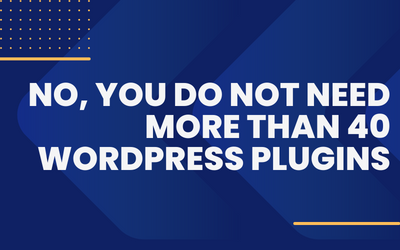Introduction
In the world of web development, the concept of headless WordPress has been gaining significant traction. As traditional monolithic CMS architectures evolve, developers are increasingly adopting headless approaches to build more flexible, scalable, and interactive websites.
In this article, we will dive into the world of headless WordPress, discussing what it entails and exploring some of the most popular frameworks and tools used to implement headless WordPress sites.
Table of Contents
Understanding Headless WordPress
Traditionally, a WordPress website consists of two core components: the frontend (the theme, templates, and presentation layer) and the backend (the WordPress CMS with its admin dashboard and database). In a headless WordPress setup, the frontend and backend are decoupled, meaning they are separated from each other.
In a headless architecture, the backend (WordPress) serves as a content repository, storing all the site’s content, including posts, pages, and media. The frontend, on the other hand, is built using a separate technology stack, such as a JavaScript framework, and communicates with the WordPress backend via APIs (Application Programming Interfaces).
Common Frameworks and Tools for Headless WordPress
React
React is a popular JavaScript library for building user interfaces. It is widely used for developing headless WordPress sites due to its component-based architecture, efficient rendering, and rich ecosystem. React can consume data from the WordPress REST API, allowing developers to build highly interactive and responsive interfaces.

Next.js
Next.js is a React framework that adds server-side rendering (SSR) capabilities to React applications. It provides excellent support for headless WordPress setups, offering features like static site generation, dynamic routing, and server-side rendering of WordPress content. Next.js simplifies the process of building performant and SEO-friendly headless WordPress sites.

Gatsby
Gatsby is another popular React-based framework used for creating blazing-fast websites. It leverages GraphQL to pull data from various sources, including the WordPress REST API, and generates static HTML pages. Gatsby’s pre-rendering capabilities result in lightning-fast load times and enhanced SEO for headless WordPress sites.

Vue.js
Vue.js is a progressive JavaScript framework known for its simplicity and ease of integration. It can be used to build dynamic user interfaces in headless WordPress setups. With Vue.js, developers can consume WordPress data via the REST API, create reactive components, and build powerful single-page applications.

GraphQL
GraphQL is a query language for APIs that provides a flexible and efficient way to retrieve and manipulate data. It is often used in headless WordPress setups as an alternative to the WordPress REST API. GraphQL allows developers to fetch precisely the data they need, minimizing network requests and enabling faster and more efficient communication between the frontend and WordPress backend.

Hosting Providers for Headless WordPress
Here’s a list of hosting providers that support headless WordPress setups:
WP Engine

WP Engine offers a headless WordPress hosting solution called “Atlas” that is specifically designed for decoupled WordPress sites.
It provides robust infrastructure, security, and scalability to support headless architectures.
Kinsta

Kinsta is a managed WordPress hosting provider that supports headless WordPress setups.
With their flexible hosting environment and developer-friendly features, Kinsta is an excellent choice for hosting headless WordPress sites.
DigitalOcean

DigitalOcean is a cloud infrastructure provider that offers a range of services suitable for hosting headless WordPress sites.
With their flexible virtual machines (Droplets) and developer-friendly ecosystem, DigitalOcean provides a solid foundation for decoupled architectures.
Netlify

While primarily known as a static site hosting provider, Netlify also supports headless WordPress setups. With their seamless integration with popular static site generators and robust deployment capabilities, Netlify is a great choice for hosting decoupled WordPress sites.
Vercel

Vercel (formerly known as Zeit) is another hosting provider that specializes in static site deployments. It offers support for headless WordPress setups, enabling developers to combine WordPress as a content management system with Vercel’s powerful serverless deployment infrastructure.
AWS (Amazon Web Services)

AWS provides a wide range of hosting services, including infrastructure for headless WordPress setups. By leveraging services like AWS Elastic Beanstalk, Lambda, and API Gateway, developers can build scalable and highly available decoupled WordPress architectures.
Azure (Microsoft Azure)

Microsoft Azure offers various hosting options suitable for headless WordPress deployments. With services like Azure App Service and Azure Functions, developers can create scalable and flexible decoupled WordPress sites on the Azure cloud platform.
It’s important to note that while these hosting providers support headless WordPress setups, the specific setup and configuration may vary. It’s recommended to review each provider’s documentation and features to choose the one that best fits your project’s requirements and preferences.
When should we consider a Headless WordPress setup?
Headless WordPress is a powerful approach that offers increased flexibility and scalability for building modern websites and applications. However, it’s important to understand when it is most appropriate to use Headless WordPress. Here are some scenarios where adopting a headless architecture can be beneficial:
Custom Frontend Experience
If you have specific requirements for the frontend design, interactivity, or performance of your website, a headless approach allows you to use modern JavaScript frameworks like React, Vue.js, or Angular to build a custom frontend that precisely meets your needs. You have complete control over the user interface and can create highly interactive, dynamic, and immersive experiences.
Mobile Applications
Headless WordPress is an excellent choice when you need to integrate your WordPress content into mobile applications. By exposing WordPress data via APIs, mobile developers can consume the content and display it within their native iOS or Android applications, providing a seamless user experience across different platforms.
Multichannel Content Distribution
If you want to distribute your content across multiple channels, such as websites, mobile apps, digital signage, IoT devices, or voice assistants, a headless approach enables you to manage and deliver content through APIs. By decoupling the frontend from the backend, you can easily syndicate content across various platforms and adapt it to specific channel requirements.
Performance Optimization
Headless WordPress allows you to leverage the performance benefits of static site generators. By pre-generating static HTML pages for your content, you can achieve faster load times, better SEO, and improved scalability. This is particularly advantageous for high-traffic websites or situations where fast page rendering is crucial.
Integration with External Systems
If you need to integrate your WordPress site with external systems, such as e-commerce platforms, CRM tools, marketing automation software, or third-party APIs, a headless architecture offers greater flexibility. By consuming and manipulating data through APIs, you can seamlessly connect WordPress with other services and create a unified ecosystem.
Future Scalability and Evolvability
Headless WordPress provides a scalable foundation for your digital presence. It allows you to adapt and evolve your frontend independently of the backend, facilitating future enhancements, redesigns, or technology updates without disrupting the content management capabilities of WordPress. You can add new features, experiment with different technologies, and scale your application as needed.
While headless WordPress offers numerous benefits, it’s important to consider the complexity and development expertise required. Headless architectures involve additional development efforts, as you need to build a custom frontend and handle data retrieval and rendering. Therefore, it’s advisable to evaluate your project requirements, goals, and technical expertise to determine if a headless approach aligns with your needs.
In conclusion, headless WordPress is ideal when you require a tailored frontend experience, want to integrate with mobile apps or external systems, need multichannel content distribution, aim for performance optimization, or seek future scalability and evolvability. Assessing the specific requirements and objectives of your project will help you determine whether headless WordPress is the right choice for your website or application.










